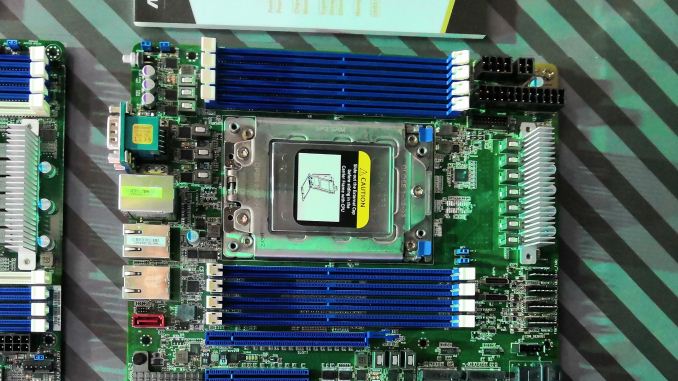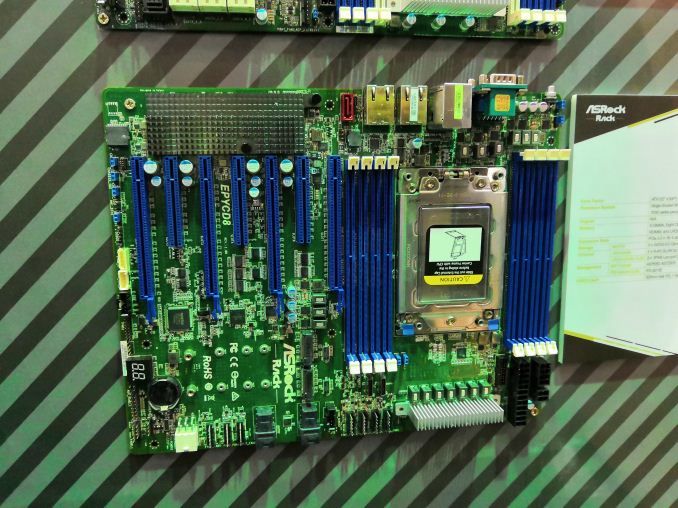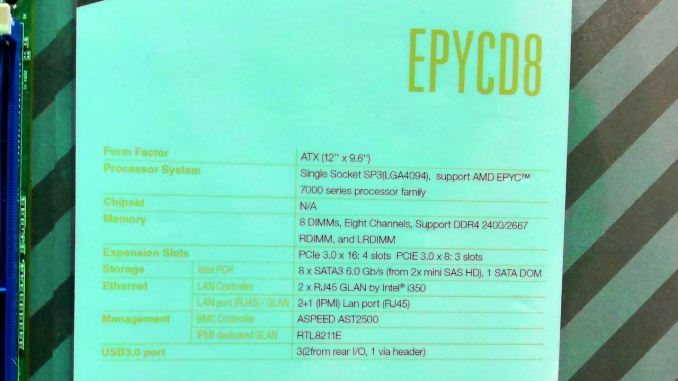ASRock Rack Goes AMD: EPYCD8 Workstation Motherboard
by Ian Cutress on June 20, 2018 11:00 AM EST
One of the lesser known companies to play in the server space is ASRock Rack, a subsidiary of the consumer focused ASRock. Much like other smaller server platform providers, ASRock Rack typically provides systems based on customer specific requirements but also offers motherboards, chassis, and various designs to distributors and end users. Up until this year, ASRock Rack was purely about Intel, with options for Xeon Scalable, Xeon D-1500, Xeon D-2100, and also the Atom C2000 Avoton and C3000 Denverton ranges. At Computex, the company showed its first AMD EPYC offering.
The EPYCD8 motherboard implements a very typical 1P workstation design, with the socket on its side in order to assist forced airflow through the heatsink and memory. In the sorts of chassis that this motherboard will go into, high-powered fans will push air from the traditional ‘right’ side of the motherboard to the left, hence the reason for this orientation.
The PCIe slot allocation looks numerous, and this arrangement also comes with dual M.2 slots and dual mini-SAS ports, taking full advantage of the EPYC platform’s PCIe lanes. As with other server-grade motherboards of this kind, the system also uses a BMC interface chip to allow the system to be managed remotely, even when the power is switched off. The Aspeed AST2500 chip and corresponding memory is found under the heatsink by the PCIe slots – it looks like a very odd heatsink, and when we asked the product manager he said that the design was not yet finalized.
Another thing to note here is the abundance of fan headers where the SATA ports usually are on a motherboard. ASRock Rack installs this motherboard into server chassis as well, so these fan headers allow the system to have all the smaller 1U high-speed fans attached with direct monitoring/control support through the motherboard and BMC.
Other standard features include dual Intel network ports (i350), support for DDR4-2400/2666 RDIMM and LRDIMM, eight SATA ports from two mini-SAS connectors, and three USB 3.0 ports. As per usual, interested customers should get in contact with their local ASRock Rack representative for more info.
We should expect to see more ASRock Rack EPYC platforms as the market becomes more used to EPYC being available.
| Want to keep up to date with all of our Computex 2018 Coverage? | ||||||
 Laptops |
 Hardware |
 Chips |
||||
| Follow AnandTech's breaking news here! | ||||||












12 Comments
View All Comments
jasaero - Wednesday, June 20, 2018 - link
Where are the EPYC 3000 boards now? ASRock has a lot of nice mITX embedded Xeon boards that now need AMD based counterparts!bill.rookard - Wednesday, June 20, 2018 - link
I don't think they could fit the socket and RAM into a mini ITX format without losing a LOT of functionality. You'd have to go SODIMM, you'd lose a bunch of memory channels because of slotting, the socket itself would have to be sideways, and that's not even considering anything close to a PCIe slot and SATA ports.DanNeely - Wednesday, June 20, 2018 - link
Even then just fitting the socket would still be problematic, they'd need to have it closer to the IO ports than it is on this board to keep it from hanging off the edge of the board; fitting connectors of any sort on the front edge of the board would need the socket practically touching the IO block.Using this board as a reference you could probably have 4 sodimms and the power connectors in the space where the top 4 dimm slots are. The space for the bottom ones would need to hold the chipset, VRMs, onboard headers, and all the other chips.
Even using riser cards and putting the m-2 on the back that'd be an extremely tight fit at best, meanwhile you'd be losing the benefit of the huge number of PCIe lanes and half the ram slots. Cooling would be a significant challenge with the 155-180W (rumored 250W for the next gen) TDP of all the mainstream Epyc parts (I'm discounting the 120W 8 core model because you can get everything that'd be able to offer in a more mainstream AMD chip). From that OEMs would almost certainly be facing elevated returns from idiots who tried sticking the board into a cases designed around lower power CPUs and either had overheading crashes or cooked the system entirely.
I'm pretty sure the answer for when it'll happen, just like with Intel's upcoming LGA3647 in mITX form, is never.
davidefreeman - Wednesday, June 20, 2018 - link
EPYC 3000 is a BGA soldered piece, and appears to use a smaller pin layout. See STH review here: https://www.servethehome.com/amd-epyc-embedded-300...DanNeely - Wednesday, June 20, 2018 - link
Topping out at 16 cores and 4 DDR channels, that's a decently cut down version of the socketed version; looks like the only spec that's the same is the one that matters the least for mITX, 64 PCIe lanes.BGA does let you pack the balls closer than anyone's managed to fit pins on a socketed chip. The flip side is that by packing the balls much closer together the initial trace fanout will require more PCB layers driving up board manufacturing costs.
I'm curious how many balls it actually does use; has that been released.
Also I notice the board's closer to mATX size than anything else (looks like a 3 slot sized design), meaning the dead area around the CPU is only marginally smaller than on the socketed version. I suppose the board could be mATX with the closest slot removed although the screw hole positions look wrong for thta. Assuming that space is specified as reserved for the cooler I'm not sure it'd any more mITXable than the socketed version.
ZeDestructor - Wednesday, June 20, 2018 - link
1. 2 banks of 2 SODIMMs is fine, if a bit expensive. That said, you can fit 4 full DIMMs on miniITX just fine if it's a single bank. The question is if you can fit 2 banks of 2 full-sized DIMMs on either side of the CPU?2. Epyc 3000 is BGA-only, so it can go in any direction. Really, Epyc 3000 is a Xeon-D competitor and fits about the same as Xeon-D
jasaero - Wednesday, June 20, 2018 - link
Yeah. I think prior commenters are confused about what Epyc 3000 is and are assuming it's the same 4 die socketed monster as 7000. It's a much smaller package than the socket on this board. I said embedded and everything...so not sure why all the confusion. AMD had very limited sales of their embedded stuff to normal pc/server/workstation/networking sorta vendors prior...but with Epyc 3000 and v1000 Zen based embedded I suspect that will change...just not sure by when?AbRASiON - Friday, June 22, 2018 - link
Very very tired of waitingAbRASiON - Friday, June 22, 2018 - link
He's talking about 3000 embedded, not 7000 full seriesJawsh - Wednesday, June 20, 2018 - link
One of the main reasons to go with Epyc is the massive number of PCIe lanes provided by the CPU. An mITX board would have at the absolute best a 16x slot and some 4x m.2 slots, and the nightmare of fitting all of the necessary components on a board that small and managing to route the connections in a reasonable amount of pcb layers would make the cost of producing a board too expensive for the few users that might buy one. Sorry, it's probably not gonna happen... as much as I'd like one too.